engine GMC YUKON DENALI 2003 Repair Manual
[x] Cancel search | Manufacturer: GMC, Model Year: 2003, Model line: YUKON DENALI, Model: GMC YUKON DENALI 2003Pages: 447, PDF Size: 21.97 MB
Page 285 of 447
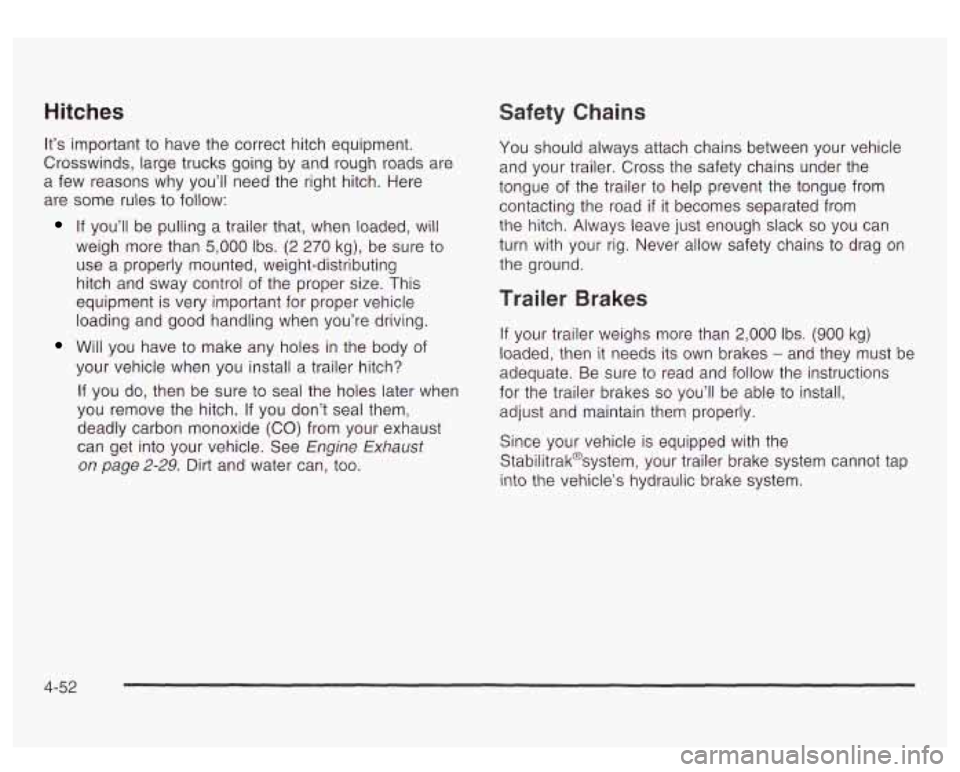
Hitches Safety Chains
It’s important to have the correct hitch equipment.
Crosswinds, large trucks going by and rough roads are
a few reasons why you’ll need the right hitch. Here
are some rules
to follow:
If you’ll be pulling a trailer that, when loaded, will
weigh more than
5,000 Ibs. (2 270 kg), be sure to
use a properly mounted, weight-distributing
hitch and sway control of the proper size. This
equipment is very important for proper vehicle
loading and good handling when you’re driving.
Will you have to make any holes in the body of
your vehicle when you install a trailer hitch?
If you do, then be sure to seal the holes later when
you remove the hitch. If you don’t seal them,
deadly carbon monoxide (CO) from your exhaust
can get into your vehicle. See Engine Exhaust
on
page 2-29. Dirt and water can, too.
You should always attach chains between your vehicle
and your trailer. Cross the safety chains under the
tongue of the trailer
to help prevent the tongue from
contacting the road
if it becomes separated from
the hitch. Always leave just enough slack
so you can
turn with your rig. Never allow safety chains to drag on
the ground.
Trailer Brakes
If your trailer weighs more than 2,000 Ibs. (900 kg)
loaded, then it needs its
own brakes - and they must be
adequate. Be sure
to read and follow the instructions
for the trailer brakes
so you’ll be able to install,
adjust and maintain them properly.
Since your vehicle is equipped with the
Stabilitrak@system, your trailer brake system cannot tap
into the vehicle’s hydraulic brake system.
4-52
Page 286 of 447
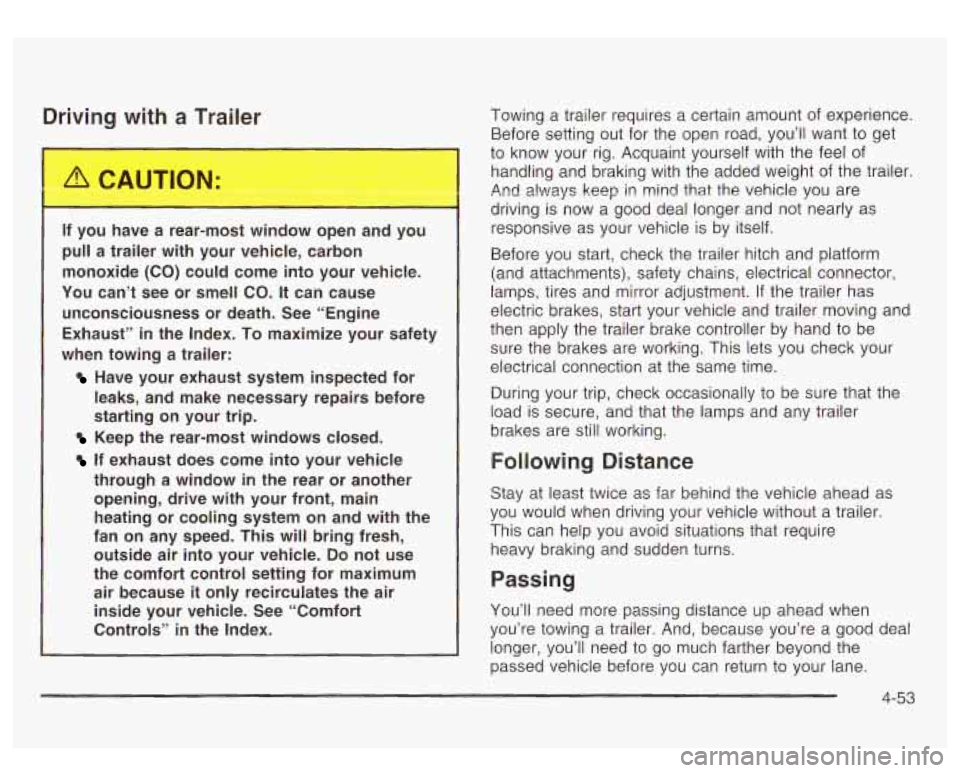
Driving with a Trailer
If you have a rear-most window open and you
pull a trailer with your vehicle, carbon
monoxide (CO) could come into your vehicle.
You can’t see or smell CO.
It can cause
unconsciousness or death. See “Engine
Exhaust” in the Index.
To maximize your safety
when towing a trailer:
Have your exhaust system inspected for
leaks, and make necessary repairs before
starting on your trip.
Keep the rear-most windows closed.
If exhaust does come into your vehicle
through a window in the rear or another
opening, drive with your front, main
heating or cooling system on and with the
fan on any speed. This will bring fresh,
outside air into your vehicle.
Do not use
the comfort control setting for maximum
air because
it only recirculates the air
inside your vehicle. See “Comfort
1 Controls” in the Index. Towing a trailer requires a certain amount
of experience.
Before setting out for the open road, you’ll want to get
to know your rig. Acquaint yourself with the feel of
handling and braking with the added weight of the trailer.
And always keep
in mind that the vehicle you are
driving is now a good deal longer and not nearly as
responsive as your vehicle is by itself.
Before you start, check the trailer hitch and platform
(and attachments), safety chains, electrical connector,
lamps, tires and mirror adjustment.
If the trailer has
electric brakes, start your vehicle and trailer moving and
then apply the trailer brake controller by hand to be
sure the brakes are working. This lets you check your
electrical connection at the same time.
During your trip, check occasionally to be sure that the
load is secure, and that the lamps and any trailer
brakes are still working.
Following Distance
Stay at least twice as far behind the vehicle ahead a5
you would when driving your vehicle without a trailer.
This can help you avoid situations that require
heavy braking and sudden turns.
Passing
You’ll need more passing distance up ahead when
you’re towing a trailer. And, because you’re a good deal
longer, you’ll need to go much farther beyond the
passed vehicle before you can return to your lane.
4-53
Page 287 of 447

Backing Up
Hold the bottom of the steering wheel with one hand.
Then,
to move the trailer to the left, just move that hand
to the left. To move the trailer to the right, move your
hand
to the right. Always back up slowly and, if possible,
have someone guide you.
Making Turns
Notice: Making very sharp turns while trailering
could
cause the trailer to come in contact with the
vehicle. Your vehicle could
be damaged. Avoid
making very sharp turns while trailering.
When you’re turning with a trailer, make wider turns
than normal.
Do this so your trailer won’t strike
soft shoulders, curbs, road signs, trees or other objects.
Avoid jerky or sudden maneuvers. Signal well in
advance.
Turn Signals When Towing a Trailer
The arrows on your instrument panel will flash whenever
you signal a turn or lane change. Properly hooked up,
the trailer lamps will also flash, telling other drivers
you’re about
to turn, change lanes or stop.
When towing a trailer, the arrows on your instrument panel will flash for turns even
if the bulbs on the trailer
are burned out. Thus, you may think drivers behind
4-54
you are seeing your signal when they are not. It’s
important to check occasionally to be sure the trailer
bulbs are still working.
Driving On Grades
Reduce speed and shift to a lower gear before you start
down a long or steep downgrade.
If you don’t shift
down, you might have to use your brakes
so much that
they would get hot and no longer work well.
You can tow in
DRIVE (D). You may want to shift the
transmission
to THIRD (3) or, if necessary, a lower gear
selection
if the transmission shifts too often
(e.g., under heavy loads and/or hilly conditions).
You may also want
to activate the tow/haul mode if the
transmission shifts
too often. See “Tow/Haul Mode”
under Towing a Trailer
on page 4-47.
When towing at high altitude on steep uphill grades,
consider the following: Engine coolant will boil at a lower
temperature than at normal altitudes.
If you turn your
engine
off immediately after towing at high altitude
on steep uphill grades, your vehicle may show signs
similar
to engine overheating. To avoid this, let the
engine run while parked (preferably on level ground)
with the automatic transmission in PARK (P) for a
few minutes before turning the engine
off. If you do get
the overheat warning, see Engine Overheating
on
page 5-25.
Page 288 of 447
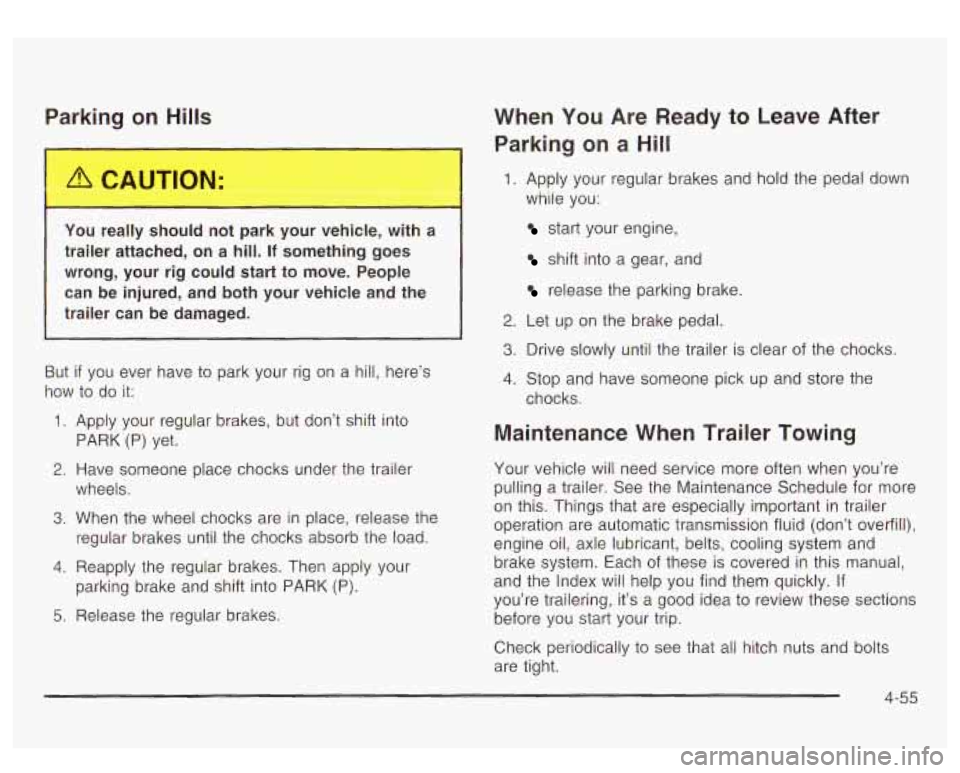
Parking on Hills
You really should not park your vehicle, with a
trailer attached, on a hill.
If something goes
wrong, your rig could start to move. People
can be injured, and both your vehicle and the
trailer can be damaged.
But if you ever have to park your rig on a hill, here’s
how to do it:
1. Apply your regular brakes, but don’t shift into
2. Have someone place chocks under the trailer
3. When the wheel chocks are in place, release the
PARK
(P) yet.
wheels.
regular brakes until the chocks absorb the load.
4. Reapply the regular brakes. Then apply your
5. Release the regular brakes.
parking brake
and shift into PARK
(P).
When You Are Ready to Leave After
Parking on a Hill
1. Apply your regular brakes and hold the pedal down
while you:
start your engine,
shift into a gear, and
release the parking brake.
2. Let up on the brake pedal.
3. Drive slowly until the trailer is clear of the chocks.
4. Stop and have someone pick up and store the
chocks.
Maintenance When Trailer Towing
Your vehicle will need service more often when you’re
pulling a trailer. See the Maintenance Schedule for more
on this. Things that are especially important in trailer
operation are automatic transmission fluid (don’t overfill),
engine
oil, axle lubricant, belts, cooling system and
brake system. Each
of these is covered in this manual,
and the Index will help you find them quickly. If
you’re trailering, it’s a good idea to review these sections
before you start your trip.
Check periodically to see that all hitch nuts and bolts
are tight.
4-55
Page 290 of 447
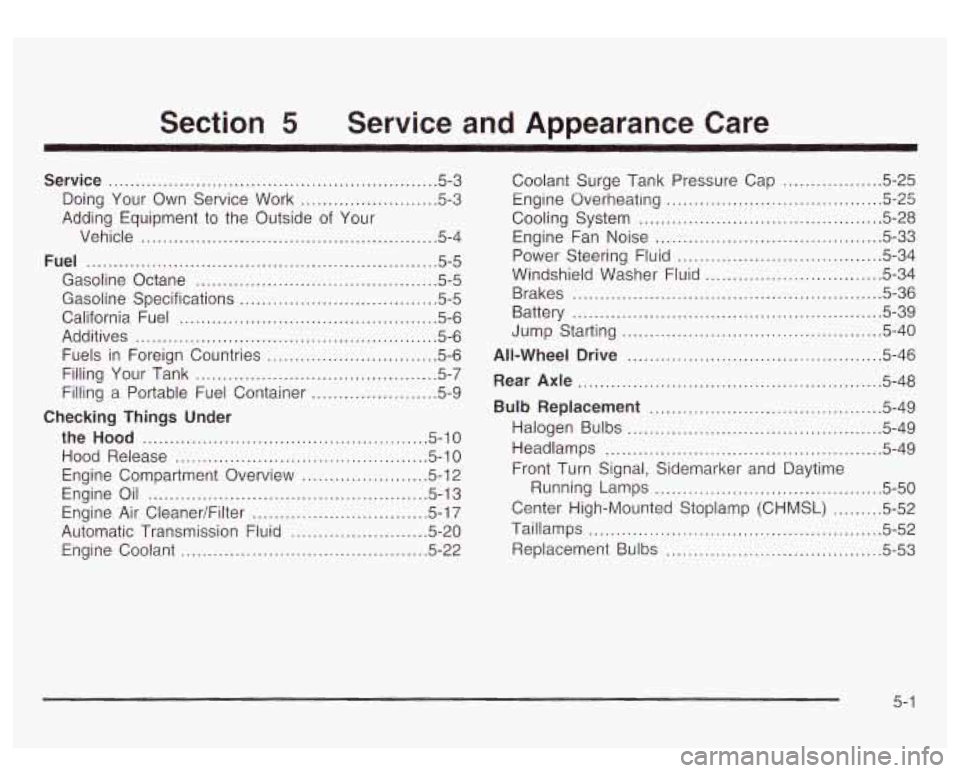
Section 5 Service and Appearance Care
Service ............................................................ 5.3
Doing Your Own Service Work
......................... 5-3
Adding Equipment
to the Outside of Your
Vehicle
.................................................. 5-4
................................................................ Fuel 5.5
Gasoline Octane ............................................ 5.5
Gasoline Specifications ................................... 5-5
California Fuel ............................................... 5-6
Additives
....................................................... 5.6
Fuels in Foreign Countries
............................... 5-6
Filling Your Tank
............................................ 5-7
Filling a Portable Fuel Container ....................... 5.9
the Hood .................... , .................... 5.10
Hood Release ...................... ................ 5-10
Engine Compartment Overview ....... ......... 5-12
Engine Oil ....................................... ..... 5.13
Engine Air Cleaner/Filter ............................. 5.17
Automatic Transmission Fluid ......................... 5-20
Engine Coolant ......................................... 5-22
Checking Things Under
~~
Coolant Surge Tank Pressure Cap ............... 5-25
Engine Overheating ....................................... 5-25
Cooling System ............................................ 5.28
Engine Fan Noise ......................................... 5.33
Power Steering Fluid
..................................... 5-34
Windshield Washer Fluid
................................ 5.34
Brakes
........................................................ 5.36
Battery
........................................................ 5-39
Jump Starting
............................................... 5.40
All-Wheel Drive .............................................. 5.46
Rear Axle .................................. .......... 5-48
Bulb Replacement .......................................... 5-49
Halogen Bulbs .............................................. 5-49
Headlamps
.................................................. 5-49
Running Lamps
......................................... 5-50
Center High-Mounted Stoplamp (CHMSL) ......... 5-52
Taillamps ..................................................... 5-52
Replacement Bulbs ................................... 5.53
Front Turn Signal, Sidemarker and Daytime
5- 1
Page 294 of 447
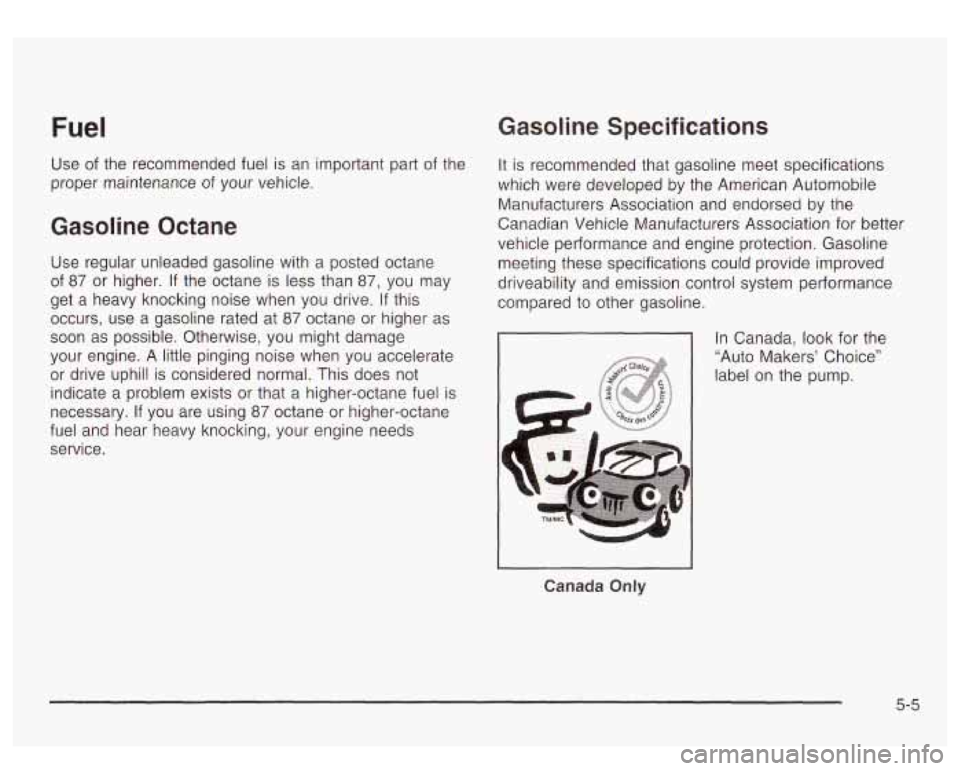
Fuel
Use of the recommended fuel is an important part of the
proper maintenance
of your vehicle.
Gasoline Octane
Use regular unleaded gasoline with a posted octane
of 87 or higher.
If the octane is less than 87, you may
get a heavy knocking noise when you drive. If this
occurs, use a gasoline rated at 87 octane or higher as
soon as possible. Otherwise, you might damage
your engine.
A little pinging noise when you accelerate
or drive uphill
is considered normal. This does not
indicate a problem exists or that a higher-octane fuel is
necessary. If you are using 87 octane or higher-octane
fuel and hear heavy knocking, your engine needs
service.
Gasoline Specifications
It is recommended that gasoline meet specifications
which were developed by the American Automobile
Manufacturers Association and endorsed
by the
Canadian Vehicle Manufacturers Association for better
vehicle performance and engine protection. Gasoline meeting these specifications could provide improved
driveability and emission control system performance
compared to other gasoline.
In Canada, look for the
"Auto Makers' Choice"
label on the pump.
Canada Only
5-5
Page 295 of 447
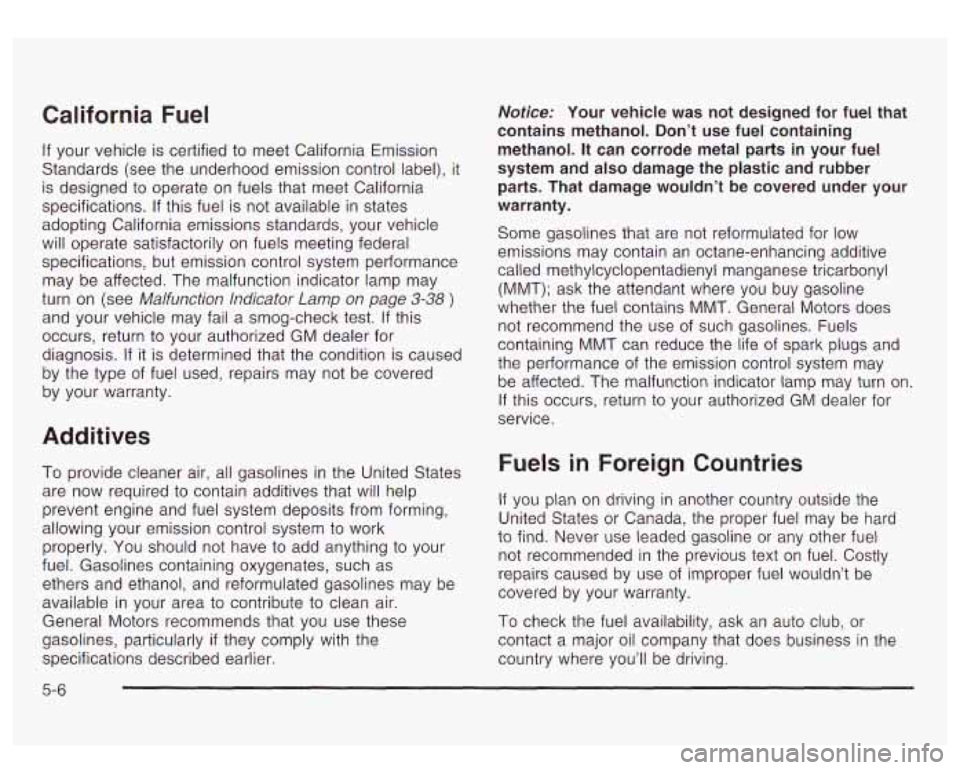
California Fuel
If your vehicle is certified to meet California Emission
Standards (see the underhood emission control label), it
is designed
to operate on fuels that meet California
specifications.
If this fuel is not available in states
adopting California emissions standards, your vehicle
will operate satisfactorily on fuels meeting federal
specifications, but emission control system performance
may be affected. The malfunction indicator lamp may
turn on (see Malfunction Indicator Lamp on page
3-38 )
and your vehicle may fail a smog-check test. If this
occurs, return
to your authorized GM dealer for
diagnosis.
If it is determined that the condition is caused
by the type of fuel used, repairs may not be covered
by your warranty.
Additives
To provide cleaner air, all gasolines in the United States
are now required to contain additives that will help
prevent engine and fuel system deposits from forming,
allowing your emission control system
to work
properly. You should not have
to add anything to your
fuel. Gasolines containing oxygenates, such as ethers and ethanol, and reformulated gasolines may be
available in your area to contribute
to clean air.
General Motors recommends that you use these
gasolines, particularly
if they comply with the
specifications described earlier.
5-6
Notice: Your vehicle was not designed for fuel that
contains methanol. Don’t use fuel containing
methanol. It can corrode metal parts in your fuel
system and also damage the plastic and rubber
parts. That damage wouldn’t be covered under your
warranty.
Some gasolines that are not reformulated for low
emissions may contain an octane-enhancing additive
called methylcyclopentadienyl manganese tricarbonyl
(MMT); ask the attendant where you buy gasoline
whether the fuel contains MMT. General Motors does
not recommend the use of such gasolines. Fuels
containing MMT can reduce the life of spark plugs and
the performance of the emission control system may
be affected. The malfunction indicator lamp may turn on.
If this occurs, return to your authorized GM dealer for
service.
Fuels in Foreign Countries
If you plan on driving in another country outside the
United States or Canada, the proper fuel may be hard
to find. Never use leaded gasoline or any other fuel
not recommended in the previous text on fuel. Costly
repairs caused by use of improper fuel wouldn’t be
covered by your warranty.
To check the fuel availability, ask an auto club, or
contact a major oil company that does business in the
country where you’ll be driving.
Page 299 of 447

Checking Things Under
the
Hood
- .lings It burn can get c hot engine parts
and start a fire. These include liquids like fuel,
oil, coolant, brake fluid, windshield washer and
other fluids, and plastic or rubber.
You or
others could be burned. Be careful not to drop
or spill things that will burn onto
a hot engine.
Hood Release
To open the hood, do the following:
1. Pull the handle located
inside the vehicle
to
the lower left of
the steering wheel.
5-1 0
Page 301 of 447

Engine Compartment Overview
When you open the hood on the VORTECTM 6000 V8 engine you will see the following:
5-1 2
Page 302 of 447
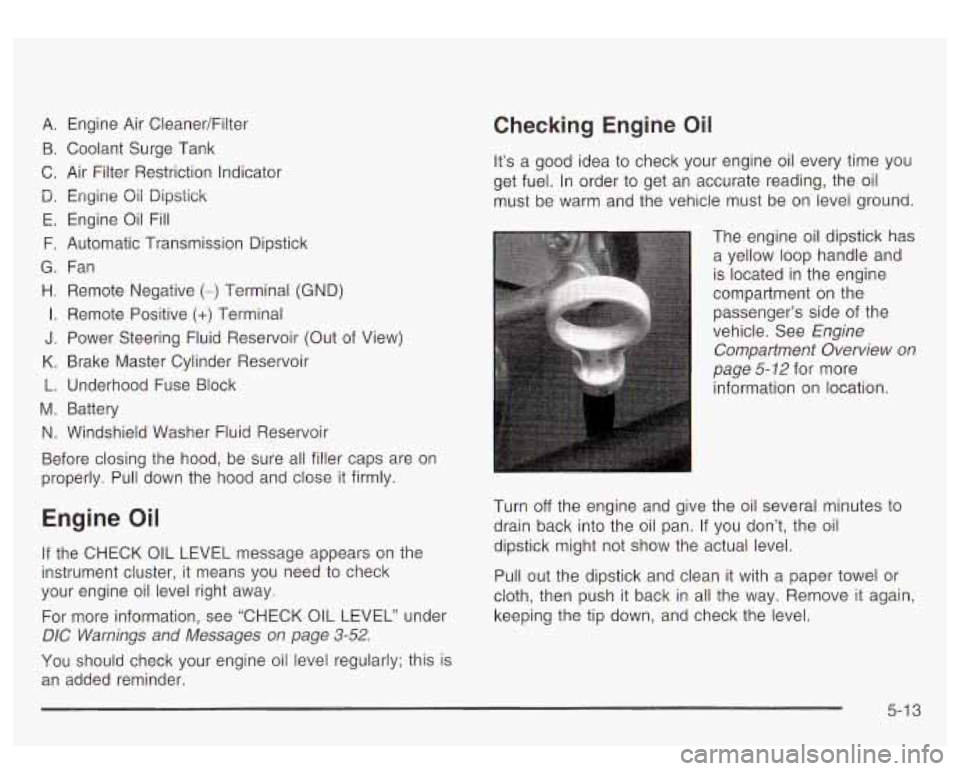
A. Engine Air CleanedFilter
B. Coolant Surge Tank
C. Air Filter Restriction Indicator
D. Engine Qii Dipstick
E. Engine Oil Fill
F. Automatic Transmission Dipstick
G. Fan
H. Remote Negative (-) Terminal (GND)
I. Remote Positive (+) Terminal
J. Power Steering Fluid Reservoir (Out of View)
K. Brake Master Cylinder Reservoir
L. Underhood Fuse Block
M. Battery
N. Windshield Washer Fluid Reservoir
Before closing the hood, be sure all filler caps are on
properly. Pull down the hood and close
it firmly.
Engine Oil
If the CHECK OIL LEVEL message appears on the
instrument cluster, it means you need to check
your engine oil level right away.
For more information, see “CHECK OIL LEVEL” under
DIC Warnings and Messages on page 3-52.
You should check your engine oil level regularly; this is
an added reminder.
Checking Engine Oil
It’s a good idea to check your engine oil every time you
get fuel. In order to get an accurate reading, the oil
must be warm and the vehicle must be on level ground.
The engine oil dipstick has a yellow loop handle and
is located in the engine
compartment on the
passenger’s side of the
vehicle. See Engine
Compartment Overview on
page
5- 12 for more
information on location.
Turn
off the engine and give the oil several minutes to
drain back into the oil pan. If you don’t, the oil
dipstick might not show the actual level.
Pull out the dipstick and clean it with a paper towel or
cloth, then push it back in all the way. Remove it again,
keeping the tip down, and check the level.
5-1 3